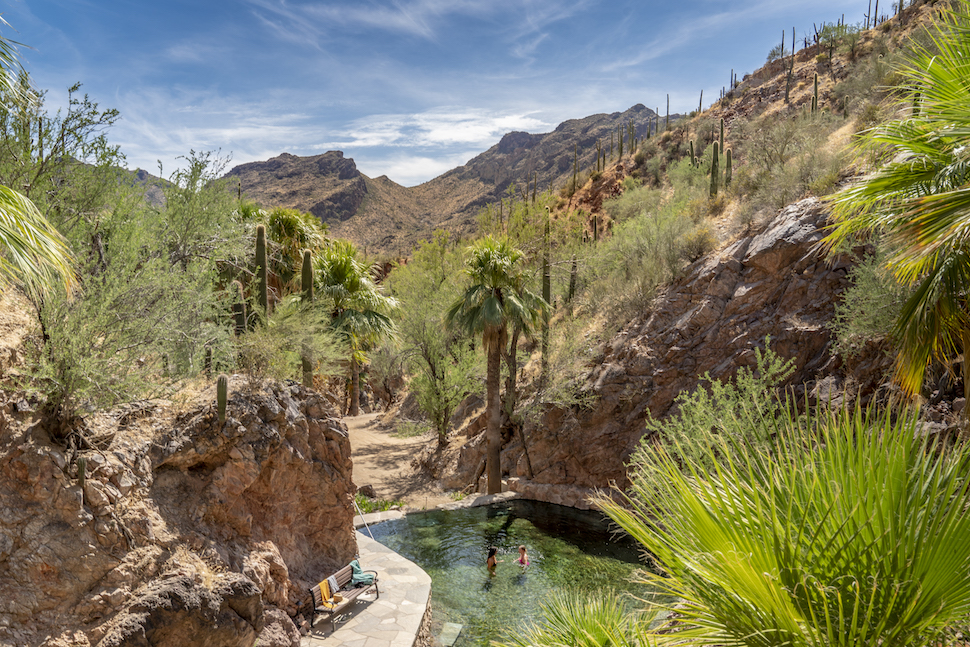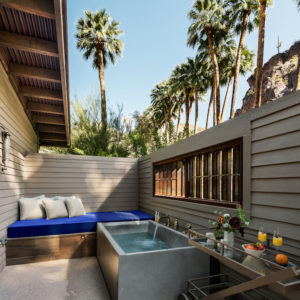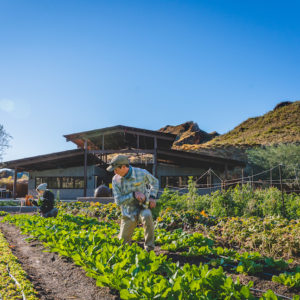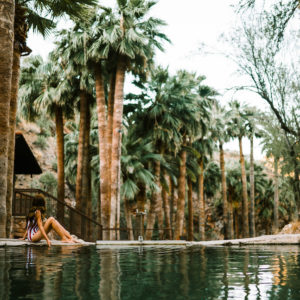
In a remote desert canyon in the Bradshaw Mountains, about ninety minutes north of Phoenix, Arizona, some 200,000 gallons of clear, velvety hot water pours out of fissures in the rock every day at a place known as Castle Hot Springs. If you were a Yavapai Indian, the hot springs were sacred, the place to name babies. If you were a prospector, the springs were salvation, more valuable than gold. If you were an entrepreneur, the springs were a stagecoach stop as well as a healing center for taking the waters. If you were a visionary, the springs were the site for Arizona’s first territorial capital, first telephone, first golf course, and first upper-crust resort. If you were a Rockefeller, Astor, or Pew, the springs were the place to winter. If you were Cecil B. DeMille, the springs were a base to film Westerns. If you were JFK, the springs were the place to recuperate from PT-109. And if you were a guest at the springs on Dec 11, 1976, you were rousted from bed as the glorious hotel burned to the ground. And by then, hot tubs had captured the public consciousness and the desert oasis could no longer compete. The great stories essentially stopped.
But if you are Mike and Cindy Watts, who made their fortune with a company called Sunstate Equipment, you have the time, resources, vision, tenacity, and passion to overlook forty years of false starts and neglect to put the storied hot springs back on the map. Remarkably, it’s working.
The funky old soul of the place hasn’t changed, which on reflection is brilliant.
The Watts were not on property during our visit, but we experienced many versions of what may be the story behind their typically sold-out success. The first version came from the young man who made our now dusty rental car disappear and then drove us by golf cart up the narrow canyon to see the springs. Somewhat to our surprise, the sequence of pools that were built in the late 1800’s remains essentially the same. In other words, the funky old soul of the place hasn’t changed, which on reflection is brilliant. The old pools instantly take you back to simpler times and the grand memories of the past.
 Equally brilliant is that there is nothing old or funky about the accommodations. The burned hotel was not rebuilt but replaced with bungalows, each sporting both indoor and outdoor fireplaces and a massive outdoor soaking tub with unlimited, guilt-free hot water—fresh from the springs and still under the stars. (We didn’t feel like walking back to the spring our first night, so we relaxed instead in the glorious privacy of our patio tub.) Inside the bungalow there’s nothing frilly or extraneous. Call it Spartan super-luxe. The WIFI password says it all: RUSUREUWANT2. But getting back to the young man who introduced us to the pools and our room: He was not just helpful. He was bursting with pride for his place of work.
Equally brilliant is that there is nothing old or funky about the accommodations. The burned hotel was not rebuilt but replaced with bungalows, each sporting both indoor and outdoor fireplaces and a massive outdoor soaking tub with unlimited, guilt-free hot water—fresh from the springs and still under the stars. (We didn’t feel like walking back to the spring our first night, so we relaxed instead in the glorious privacy of our patio tub.) Inside the bungalow there’s nothing frilly or extraneous. Call it Spartan super-luxe. The WIFI password says it all: RUSUREUWANT2. But getting back to the young man who introduced us to the pools and our room: He was not just helpful. He was bursting with pride for his place of work.
That story continued the next morning on the via ferrata, a bucket-list-worthy rock-climbing adventure just a few minutes’ walk from our bungalow. The climbing guide and via ferrata course manager, Ryan Myers, proved to be one of that rare breed of passionate rock climbers who loves to teach as much as to climb. He told me of arriving four hours early for his job interview to check out the local climbing, and it turned out that a bench was to be installed that day high up on the trail. So he spent those four hours volunteering to get a heavy bench up a steep mountain. He was a little miffed at himself for working so hard for free, but it was the sort of challenge he loved, and he was then hired to help design and install the steel cables and ladders of the via ferrata, which allow pretty much anyone to have an experience that includes vertical-wall climbing, hundreds of feet above the canyon floor. The climb is truly grand and scary and very safe fun—and Ryan’s smile was as big as all of ours. “I get paid to do this,” he beamed.
 David Bullock, the farm operations manager, radiates a similar story. He clearly lives to grow things, whether they’re heirlooms or some new hybrid he’s creating—something never seen or tasted before. Out in this desert oasis, he has plenty of sun and great soil and all the water he needs, but he also has heat from the springs. And that means, for example, that he can keep his citrus trees from freezing outside in the winter and his gorgeous greenhouse is naturally heated for whatever he can dream up. During his farm tour, which was remarkably entertaining, one could also see that he’s in constant competition with the chef, who is out picking. The gardener playfully accuses his chef of not taking perfect advantages of his garden—which is kind of funny because if you take the back door into the kitchen you walk through a virtual apothecary of herbs and spices grown right outside, as well as all the fresh-picked produce that shapes the menu. Co-chefs John Amann and Chris Schuetta really know how to play with food, and their five-course dinner tasting menus are amazing.
David Bullock, the farm operations manager, radiates a similar story. He clearly lives to grow things, whether they’re heirlooms or some new hybrid he’s creating—something never seen or tasted before. Out in this desert oasis, he has plenty of sun and great soil and all the water he needs, but he also has heat from the springs. And that means, for example, that he can keep his citrus trees from freezing outside in the winter and his gorgeous greenhouse is naturally heated for whatever he can dream up. During his farm tour, which was remarkably entertaining, one could also see that he’s in constant competition with the chef, who is out picking. The gardener playfully accuses his chef of not taking perfect advantages of his garden—which is kind of funny because if you take the back door into the kitchen you walk through a virtual apothecary of herbs and spices grown right outside, as well as all the fresh-picked produce that shapes the menu. Co-chefs John Amann and Chris Schuetta really know how to play with food, and their five-course dinner tasting menus are amazing.
And then there’s Sarah Foote, the young sommelier, who in her own way is aspiring to outdo whatever the chef and the gardens can come up with. Even the bartenders are involved because the restaurant, bar, and garden are adjacent to each other and everyone is learning, experimenting, teaching, and sharing—connected by a central challenge that starts like this:
“Whatcha got?”
“Oooh! I can create something really fun with that.”
 The spa feels like that, too—even if “spa” is a big word for the tents along the creek where treatments are now performed. But a spa experience is ultimately about the person providing the experience, and my massage therapist was remarkably talented, especially for a young mother so far from the more convenient resorts in Scottsdale. I asked where she trained and she told me the name of her school. And then she explained the reason she came to Castle Hot Springs: The Watts came to her school and hired away her instructors. She had a long drive, but got to do what she loved and keep learning—an offer she couldn’t refuse.
The spa feels like that, too—even if “spa” is a big word for the tents along the creek where treatments are now performed. But a spa experience is ultimately about the person providing the experience, and my massage therapist was remarkably talented, especially for a young mother so far from the more convenient resorts in Scottsdale. I asked where she trained and she told me the name of her school. And then she explained the reason she came to Castle Hot Springs: The Watts came to her school and hired away her instructors. She had a long drive, but got to do what she loved and keep learning—an offer she couldn’t refuse.
As we drove back down the dusty dirt road toward Phoenix, one question nagged: Who are the Watts? My wife and I have experienced many properties developed by very wealthy and passionate people that don’t really work—grand but idiosyncratic dreams kept afloat by endless cash. Castle Hot Springs is not one of those. So, I finally googled the Watts to find out what else they had done beside Sunstate Equipment, and it turns out that they have used their money for a variety of philanthropic endeavors, including the Watts College of Public Service and Community Solutions at Arizona State University. As Mike Watts writes about his college, “I have always felt that giving people a reason to be optimistic, to believe in dreams is important. Part of the initiative that we hope to work with the college on is the development of that: a belief system—not just in themselves, but in the opportunities that exist.” Add that dream to a couple hundred thousand gallons of hot water and you’ve got something special.
Stephen Kiesling
Stephen Kiesling is a writer and editor whose career was launched in 1982 with the classic rowing book The Shell Game and The New York Times Book Review, “Just as it is good that there was a riverboat pilot who could write…it is good that there is one true blue jock who can.” A Scholar of the House in philosophy at Yale, Stephen was a 1980 Olympic oarsman who also raced in the 2008 Olympic Trials. He learned journalism from T George Harris, a decorated World War II artillery scout and Time reporter who created Psychology Today. T George and Stephen launched both American Health magazine and Spirituality & Health, where Stephen continues as Editor at Large. He has written for the New Yorker, Sports Illustrated and Outside, was a spokesman for Nike, started a celebrated rowing club, and has built parks and playgrounds. He lives at Ti’lomikh Falls on the Rogue River in southern Oregon, where he writes for his wife Mary Bemis at Insidersguidetospas.com. Stephen is also the caretaker of one of America’s oldest Salmon Ceremonies and is working on a whitewater park and sculpture garden. He is interested in transformational retreats, anything to do with water, the Native American origins of our democracy, and the process of becoming what he calls an Earth-Indigenous Elder, a person who knows their own story from the beginning of time.